Few members of the Tandon Lab attended the workshop on “Prediction and Variability of Air-Sea Interactions: the South Asian Monsoon” which was held at Institute for Computational & Experimental Research in Mathematics (ICERM), Brown University, Providence. Prof Tandon was a co-organizer of that workshop while Sid Kerhalkar and Dr. Suraj Singh attended the workshop.
Exploring the upper ocean
Tandon Laboratory at UMass Dartmouth
Author: sid (page 3 of 5)
Members of the Tandon lab attended the Gordon Research Conference (GRC) 2022 on Ocean Mixing which was held at Mount Holyoke College, South Hadley, Massachusetts in June 2022. The goal of this conference was to bring together disparate groups to identify and describe critical elements of mixing physics that are most important in reducing the uncertainty in model predictions on all scales – spanning from rapid, small-scale dynamics to multi-decade, global impacts. This brought together observational, theoretical, experimental, and numerical communities which advanced our understanding of ocean mixing and further tackle applied problems that have most societal relevance.
Prof Tandon was a discussion leader for the session “Submesoscale and Finescale Processes: Fronts, Instabilities and Turbulence”, while Iury Simoes-Sousa, Filipe Pereira, Sid Kerhalkar and Dr. Suraj Singh presented their work in the form of poster presentations. Some of them also participated in the Gordon Research seminar, which was a platform for Early Career Scientists (ECR’s) to showcase their research. Attending this conference not only advanced the scientific knowledge of the lab members, but it also initiated discussions about mentoring through the power hour and peer-mentoring program of the GRC.
PS: We do not have pictures from the talks as the conference has a strict no-pictures policy.
Tandon Team were a part of the champions cohort in the recently concluded NASA Openscapes program over the Spring 2022. This program is led remotely and is designed to ignite incremental and sustainable change within research groups — and beyond. Discussions focus around collaborative mindsets, norms, and software to enable open, reproducible, inclusive research, introducing tools like R, tidyverse, RMarkdown, GitHub, Google Drive, and Twitter and practices from open source communities. This year’s theme was also concentrated on using NASA Earthdata and transitioning workflows to the Cloud.
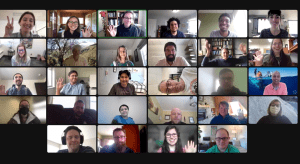
NASA Openscapes Champions Cohort 2022
Participating members include Profs Tandon and Buckingham, Suraj, Valentina, Iury, Filipe, Sid and Ersen’S.
Tandon lab had a strong presence in the 26th annual Sigma Xi research exhibit held at Claire T. Carney Library, UMass Dartmouth in April 2022, with 6 members presenting and a second-place winner.
Iury presented his work on the atmospheric cold pools in the Bay of Bengal, Alan talked about the resonance in mooring lines due to vortex shedding, Ersen’s presented his REU project on Satellite imagery and Numerical modeling in the Bay of Bengal, Patrick demonstrating the in-house developed Aurelia profiler and Sid presented his results on Diurnal Warm Layers. Filipe showed his work from the baroclinically unstable meander in the South Atlantic and its ecological implications and was announced as the second best poster in the exhibit.
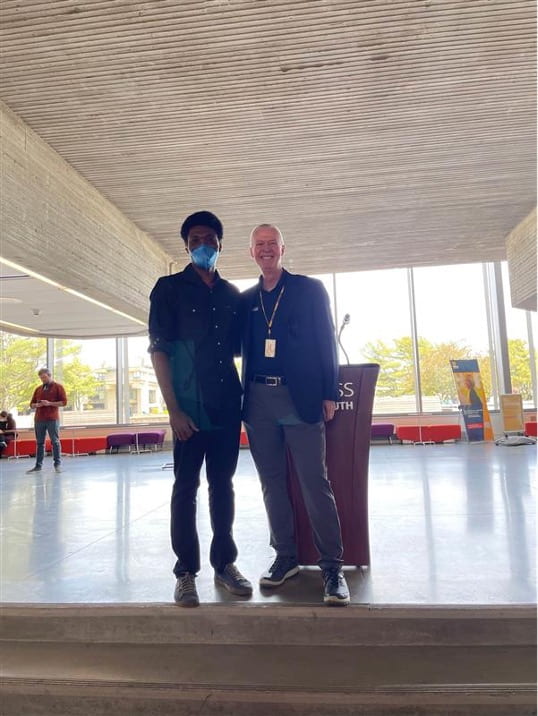
Filipe receiving his prize from Chancellor Fuller
Congratulations Filipe!
A paper by Caique Luko (an M.S student from University of São Paulo co-advised by Prof. Tandon) titled “Effects of the seasonality of mesoscale eddies on the planktonic dynamics off eastern Brazil” has been published in Dynamics of Atmosphere and Ocean with Prof. Tandon and Filipe Pereira (a PhD candidate from the USP-UMassD dual-degree program) as some of the co-authors of the paper. This study was aimed to understand if the seasonality of these mesoscale eddies affects the regional phytoplankton annual cycle. To achieve that, the authors analyzed chlorophyll-a satellite observations and performed two experiments using a Nutrients-Phytoplankton-Zooplankton (NPZ) model coupled to a 1 and a 1/2 -layer Quasi-Geostrophic model.
The results reveal that the phytoplankton annual cycle off eastern Brazil is mainly controlled by the seasonally varying advection of material offshore caused by the mesoscale eddies. Such mechanism may represent an important source of material to the tropical oligotrophic ocean. More on this study could be found here.
Congratulations Caique, Filipe and Prof Tandon!!
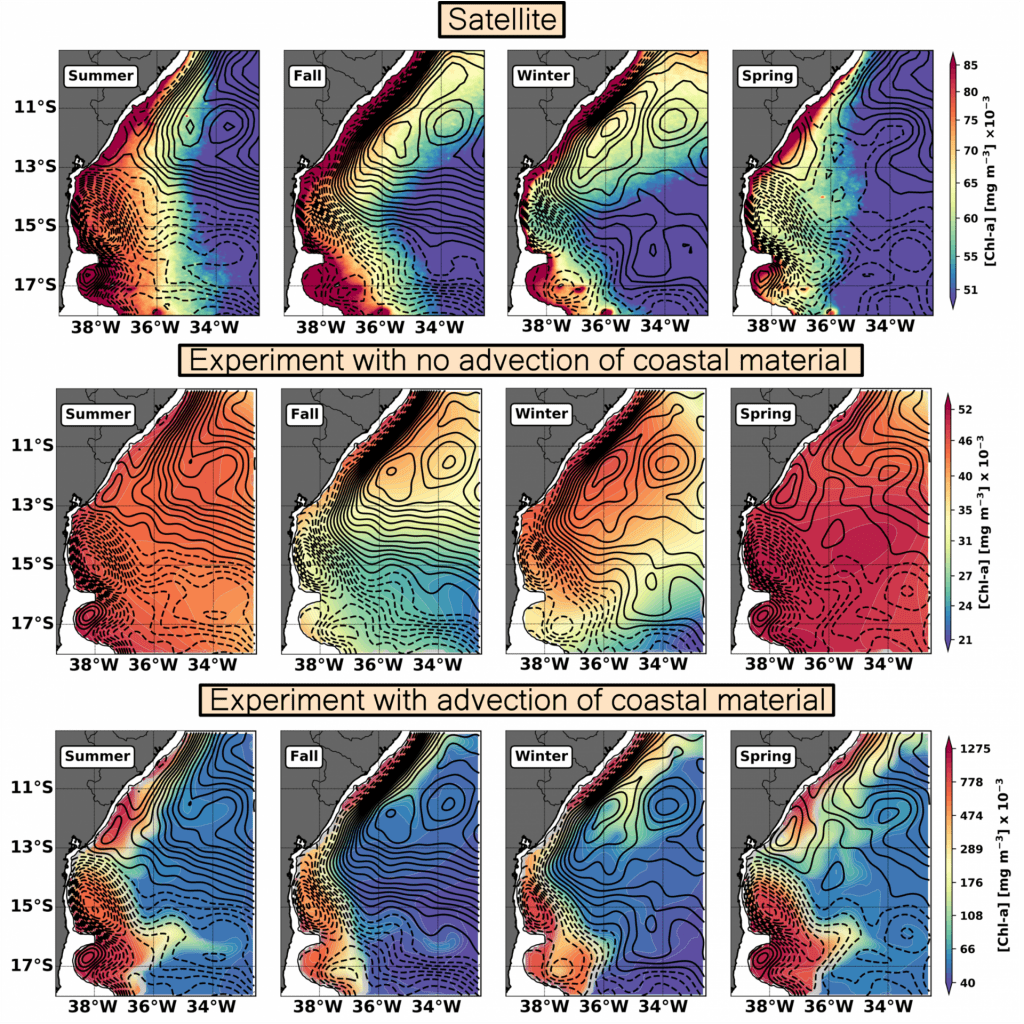
Horizontal distributions of the streamlines and the Chl-a obtained in: (1 st row) Satellite observations; (2 nd row) Experiment with no advection of enriched coastal material; and (3 rd row) Experiment with advection of enriched coastal material. Average scenarios of: (1 st column) summer; (2 nd column) fall; (3 rd column) winter and; (4 th column) spring. The concentration of chlorophyll-a is on a logarithmic scale. Dashed lines represent negative streamlines, and solid lines represent positive streamlines. The white shaded area masks regions shallower than 100 m.
Inter-campus Marine Science (IMS) program at University of Massachusetts organized their annual symposium at UMass Dartmouth in March 2022. This event marked the return of the in-person gathering at this symposium. Researchers from the five UMass campuses (Amherst, Boston, Dartmouth, Lowell and Worcester) gather to discuss their work in marine sciences.
Iury Simoes-Sousa was invited to present a plenary talk on “Atmospheric cold pools in the Bay of Bengal”, while Adriano Giangiardi Filho, Filipe Pereira, Sid Kerhalkar, Patrick Pasteris and Ersen’S Joseph presented posters. Their posters can be found here . Sid was also one of the student organizers of the IMS symposium.

Iury presenting a plenary talk at IMS symposium 2022
Adriano won the best poster award in the Oceanography section. Congratulations Adriano!
Prof Amit Tandon and the rest of the lab had strong participation in the recently concluded Ocean Sciences Meeting-2022. Originally planned to be in Hawaii, the pandemic forced the organizers (AGU, ASLO, TOS) to make the event virtual. Spread across 7 days in February and March, it was definitely a good experience for the group to be a part of this event by presenting their published/on-going work as well as attending lots of other talks from a plethora of topics being discussed. Following are the details of the talks either given by the lab members or with Prof Tandon as a co-author.
1) Topographically-Generated Submesoscale Shear Instabilities associated with Brazil Current Meanders: Caique Luko
2) Diurnal Warm Layers in the Bay of Bengal during Monsoon 2019: Siddhant Kerhalkar
3) Atmospheric Cold Pools in the Bay of Bengal: Iury T.Simoes Sousa
4) Dynamics of a Baroclinically-unstable Meander and its Ecological Impacts: Filipe Pereira
5) Validation of a Hybrid Co-ordinate Ocean Model (HYCOM) in the Eastern Tropical North Pacific Oxygen Deficient Zone: Valentina Guinta
6) Next steps toward understanding Arabian Sea dynamics and ecology: Amit Tandon
7) Energy Exchange Between Internal Gravity Waves and Balanced Flow: Wave Action Conservation and a pathway to Dissipation: Eric Kunze (with Amit Tandon)
8) Reabsorption of Lee-Wave Energy in Bottom-Intensified Currents: Yue Wu (with Amit Tandon)
9) Incorporating irreversible fluxes in K-e mixing model for Bay of Bengal: Shikha Singh (with Amit Tandon)
10) Characteristics and Variability of Air-sea fluxes in Bay of Bengal from OMNI Buoy Measurements: Jossia Joseph (with Amit Tandon)
11) Wave Induced Stokes Drift from a decade of Moored Buoy Observations in the Bay of Bengal: Kalyani M (with Amit Tandon).
Along with these 11 talks, Prof Tandon was also a session chair for the session “PL04- Indian Ocean circulation and its impact on air-sea interactions, biogeochemistry and ecology”.
A paper by Dr Caue Lazaneo (a former PhD student in Tandon Lab) has just been published in JGR-Ocean titled “Submesoscale Coherent Vortices in the South Atlantic Ocean: A Pathway for Energy Dissipation” with Prof Amit Tandon as one of the co-authors. This paper is motivated by observations during summer 2017 aboard R/V Alpha-Crucis as a part of “Islands” experiment. This paper shows the role of seamounts in the generation of submesoscale features due to the interaction of the rich mesoscale eddy field with the local topography. The paper could be found here.
Congratulations Caue and Prof Tandon!
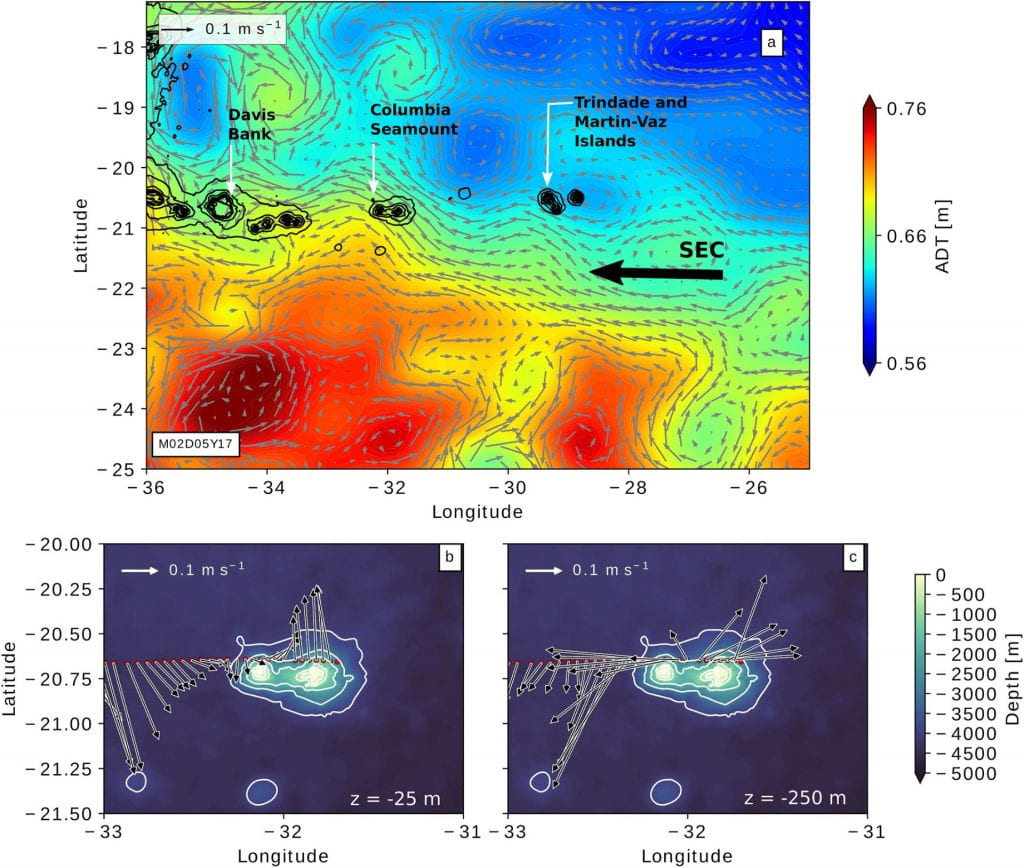
A plain language summary of the paper appears below:
The interaction between topography and oceanic flows results in the development of small-scale turbulent phenomena. The occurrence of such phenomena is significant for the ocean energy balance due to energy dissipation, which occurs on spatial scales smaller than a centimeter. In this study, we describe, for the first time in the western South Atlantic Ocean, the physics of two adjacent submesoscale coherent vortices in the vicinity of the Vitória-Trindade Ridge. These vortices have radii of 12 and 16 km and a subsurface signature with intensified velocity and weak stratification. Since this type of vortex has no surface expression, it is challenging to detect it due to its small horizontal scale. Microstructure measurements collected by a ship inside and outside the vortex enable us to evaluate, for the first time, its influence on energy dissipation and ocean mixing.
A paper by Ms Jossia Joseph (Scientist-E at National Institute of Ocean Technology) has just been published in Journal of Atmospheric and Oceanic Technology titled “Longwave Radiation Corrections for the OMNI Buoy Network” with Prof Amit Tandon as one of the co-authors. This paper describes corrections performed in the OMNI Buoy network when there was an over-estimation of Longwave Radiation in OMNI Buoy network found when compared with a nearby mooring from Woods Hole Oceanographic Institute (WHOI) during 2015 ASIRI experiment. The paper can be found here.
Congratulations Jossia and Prof Tandon!
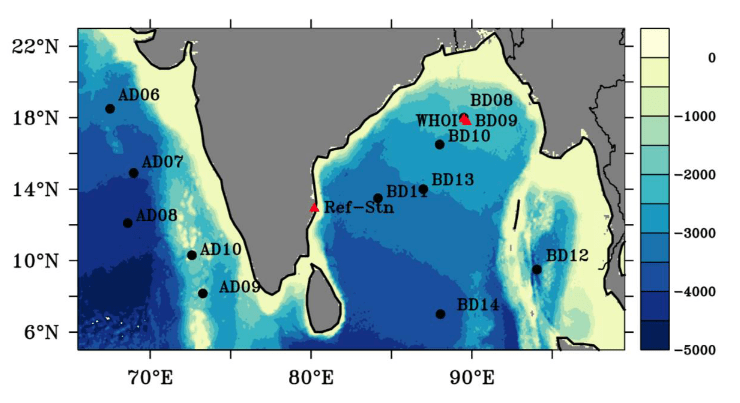
OMNI Buoy Network (figure-1 of paper)

A major result showing corrections in Longwave radiation calculations (figure-10 of the paper).
The abstract of this study appears below:
The inception of a moored buoy network in the northern Indian Ocean in 1997 paved the way for systematic collection of longterm time series observations of meteorological and oceanographic parameters. This buoy network was revamped in 2011 with OMNI (Ocean Moored buoy Network for north Indian Ocean) buoys fitted with additional sensors to better quantify the air-sea fluxes. An inter-comparison of OMNI buoy measurements with the nearby WHOI mooring during the year 2015 revealed an overestimation of downwelling longwave radiation (LWR↓). Analysis of the OMNI and WHOI radiation sensors at a test station at NIOT during 2019 revealed that the accurate and stable amplification of the thermopile voltage records along with the customized data logger in the WHOI system results in better estimations of LWR↓. The offset in NIOT measured LWR↓ is estimated firstly by segregating the LWR↓ during clear sky conditions identified using the downwelling shortwave radiation measurements from the same test station, and secondly, finding the offset by taking the difference with expected theoretical clear sky LWR↓. The corrected LWR↓ exhibited good agreement with that of collocated WHOI measurements, with a correlation of 0.93. This method is applied to the OMNI field measurements and again compared with the nearby WHOI mooring measurements, exhibiting a better correlation of 0.95. This work has led to the revamping of radiation measurements in OMNI buoys and provides a reliable method to correct past measurements and improve estimation of air-sea fluxes in the Indian Ocean.
The University of Massachusetts System Office of Technology Commercialization and Ventures (OTCV) recently announced the recipients of their 2021 grant awards for their innovative research proposals which include UMass Dartmouth faculty member, Prof Amit Tandon. The OTCV awards invest in faculty research and development projects that lead to further investment, workforce training, and job creation opportunities within the Commonwealth.
Professor Amit Tandon (Mechanical Engineering) and his project “Aurelia: Low-cost user-friendly depth changing vehicle for ocean sensors” dive into the issue surrounding a growing need for inexpensive devices that detect important sub-surface ocean data (e.g., temperature, salinity, currents) in the upper ocean. The Aurelia is a unique simple-to-use low-cost design advancing work done by a senior design team at UMass Dartmouth, led by Mr. Pasteris, mentored, and guided by Dr. Amit Tandon. Aurelia features a low-cost depth control system to allow several dive/surface trips, an Android graphical interface for Bluetooth programming, and a deployable antenna for retrieval after completing its mission.
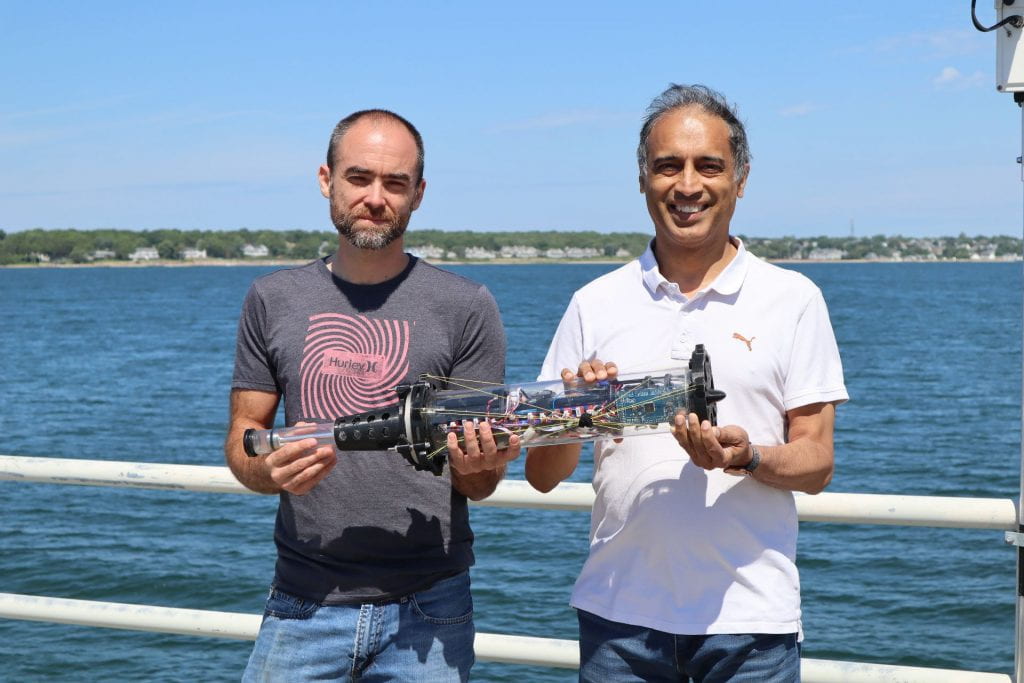
Prof Tandon and Patrick Pasteris with Aurelia profiler
© 2024 Exploring the upper ocean
Theme by Anders Noren — Up ↑
Recent Comments